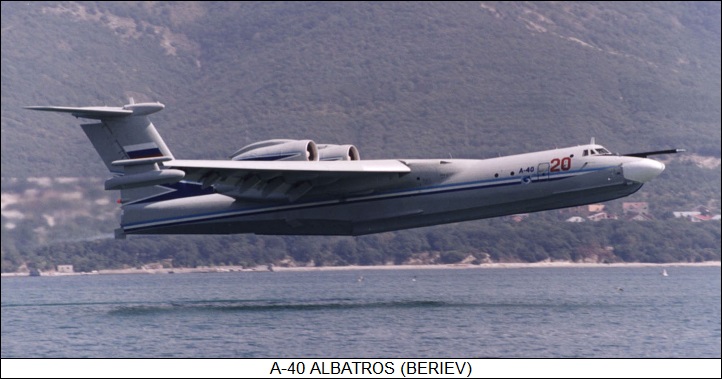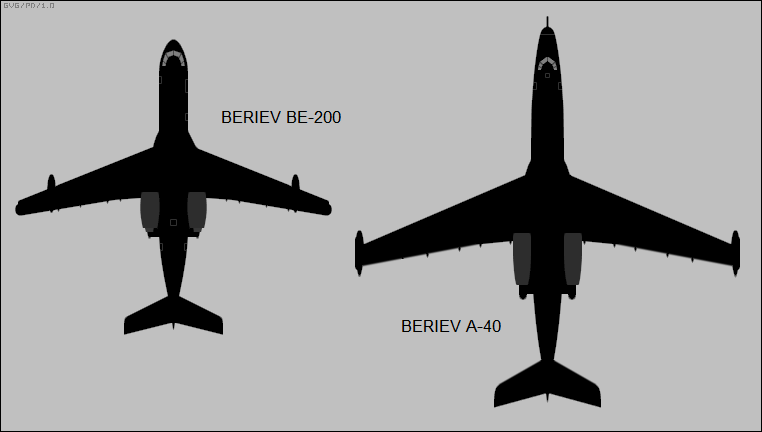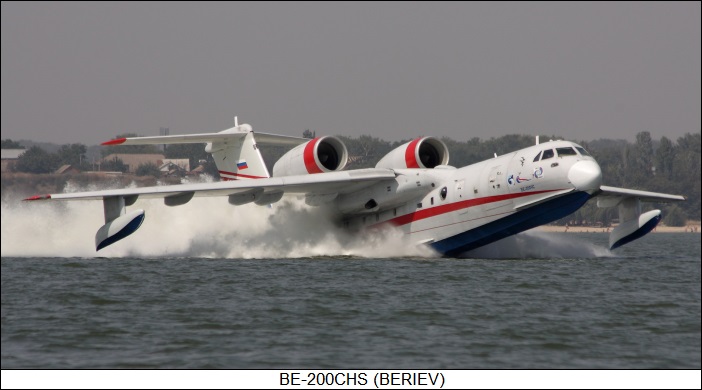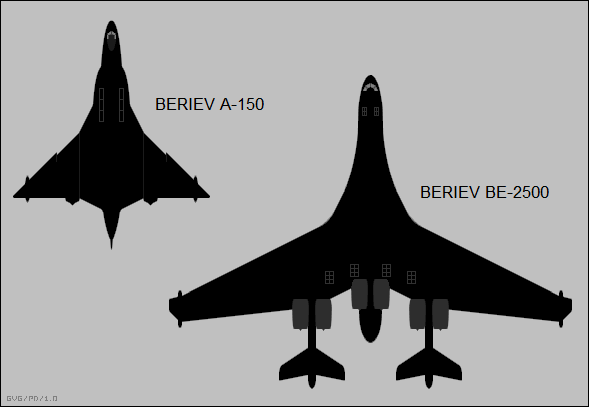
* From before World War II, Soviet aircraft designer Georgiy Mikhailovich Beriev developed a series of flying boats for the Soviet Union. In the post-Soviet era, the Beriev organization continued in that line of work, developing three flying boats: the "A-40" military jet flying boat, the "Be-200" jetliner flying boat, and the "Be-103" light civil flying boat. This document provides a history and description of the A-40, the Be-200, and the Be-103; it also discusses a number of large jet flying boat concepts considered by the organization.

* From the mid-1950s, the Beriev OKB (experimental design bureau in its Russian acronym) worked on an advanced military jet flying boat, the "Be-10", a few dozen being built, but never seeing operational service. Work on the Be-10 was paralleled by concept studies for a next-generation supersonic follow-on, but they were shelved along with the Be-10 in 1963. However, that didn't discourage Beriev engineers from considering more conservative next-generation designs from the early 1960s -- for example, a large amphibian flying boat with swept wings and four turbofans, mounted in pairs on a pylon inboard on the rear of each wing.
That specific concept never flew either, but in 1972 the Beriev OKB began studies on a large advanced jet flying boat that reflected the earlier thinking, to replace the Beriev Be-12 twin-turboprop flying boat and the Ilyushin Il-18 shore-based anti-submarine warfare (ASW) patrol aircraft. In consequence, in late 1976 the Beriev organization was instructed to begin preliminary development of the "A-40" amphibian, the design team being led by Aleksei K. Konstantinov. Full development was initiated in 1982, with a static test prototype and two flight test prototypes to be built in the Beriev facility at Taganrog, on the Sea of Azov.
The initial flight prototype of the "Albatros", as it was known, was rolled out in September 1986 and performed its first flight on 8 December 1986, the flight captain being Yevgeniy A. Lakhmostov. Actually, it wasn't supposed to fly until later, but in the course of taxi tests it proved too eager to get into the air; the pilot decided it would be safer to perform a couple of go-rounds of the airfield to get a feel of how the thing flew, before trying to take it back down on the runway.
The machine proved unstable on water take-offs and landings, suffering from a dangerous tendency to "pitch up", which was fixed by adding deflector plates behind the aircraft's boat hull "step". The first prototype put on an aerial display at the Moscow-Tushino airshow in August 1989, with NATO assigning it the flattering reporting name of "Mermaid". A second prototype followed in late 1989, with the two machines becoming prominent participants in airshows into the next decade.

* The A-40 was, allowing for a certain characteristic Soviet functionalism, an extremely attractive and impressive aircraft, well more aerodynamically "clean" than most flying boats. It was built of aircraft aluminum alloys, with some honeycomb panels, and composites. It featured a high swept wing, with fairings for the main landing gear in the wingroots and floats on pylons beneath the wingtips, a swept tee tail with a forward tailfin fillet; and a double-step boat hull with a rudder at the end. The boat hull featured an innovative "twin chine" configuration, improving water handling; there were also strakes alongside the nose and just forward of the hull step to protect the aircraft from sea spray.
The primary powerplants were twin Solovyov D-30KPV turbofans, providing 118 kN (12,000 kgp / 26,455 lbf) thrust each, mounted behind the wings on pylons above main landing gear fairings, the arrangement giving the engines maximum protection from sea spray. The D-30KPV engines were derived from the D-30KP fitted to the Ilyushin Il-76 cargolifter, the D-30KPV featuring corrosion protection but lacking thrust reversers.
While not immediately obvious on casual inspection, the A-40 also had two small Kolesov RD36-35 booster jets -- derived from the RD36 "liftjet", discussed later -- providing 23.1 kN (2,350 kgp / 5,180 lbf) thrust each. They were hidden away in the pylons mounting the D-30KPV engines, the exhaust of each booster being sealed by an "eyelid" shutter system after take-off. Apparently the inlets had doors that closed off after take-off as well, but it is difficult to determine where these doors are from sources; one good possibility being that they were at the bottom of the main engine inlet ducts, which would give good protection from sea spray. The exhaust eyelid shutters resulted in a prominent "bullet" below and behind the main engines that was the only giveaway to the presence of the booster jets. The booster engines were added to ensure adequate take-off power, unstick from a water take-off requiring a bit of oomph, and to improve safety in case of a main engine failure on take-off.
The A-40 had a TA-12 auxiliary power unit (APU) turbine for engine starting and ground power, sited on the left front of the wing center section, revealed by an intake door at that position and an exhaust under the wing. Fuel tanks were in the wing center section box, with a total fuel capacity of 35,100 liters (9,272 US gallons); there was a fixed inflight refueling probe in the nose.
The wing had a leading-edge sweep of 23 degrees 13 minutes, an incidence of 3 degrees 23 minutes, and zero dihedral. On the trailing edge, from wingtip to fuselage, each wing had an aileron, an outboard flap, and an inboard flap. The flaps were double slotted; each had two spoilers in front of it, the outboard spoilers being used for roll control, all spoilers being used as airbrakes / lift dumpers. There was a slat along the full span of the wing leading edge. Tail control surfaces were conventional: rudder and ailerons.
___________________________________________________________________
BERIEV A-40 ALBATROS:
___________________________________________________________________
wingspan:
41.62 meters (136 feet 6 inches)
wing area:
200 sq_meters (2,153 sq_feet)
length:
38.92 meters (127 feet 8 inches)
height:
11.07 meters (36 feet 3 inches)
MTO weight:
86,000 kilograms (83,655 pounds)
max cruise speed:
720 KPH (450 MPH / 390 KT)
service ceiling:
9,700 meters (31,820 feet)
range, max payload:
4,100 kilometers (2,550 miles / 2,210 NMI)
___________________________________________________________________
The steerable nose landing gear had twin wheels and retracted backwards; the main gear had four wheels each, in a 2x2 bogey arrangement, and retracted backwards into the landing gear fairings. Systems included the usual communications, navigation aid, and landing aid avionics; there was a radome for a search radar in the nose, and pods on the wingtips for an electronic intelligence (ELINT) system. It appears there were provisions for a retracting magnetic anomaly detector boom in the tail, but it is unclear to what extent the two prototypes were fitted with operational kit. There were no evident external stores pylons, with stores -- presumably including sonar buoys and the like along with homing torpedoes, bombs, mines, and other munitions -- being carried in a weapons bay under the rear fuselage.
There were eight crew, including pilot, copilot, radio operator, flight engineer, navigator, and three observers. Cockpit layout was analog; accommodations were pressurized and climate-conditioned. There was a door on each side of the aircraft behind the cockpit -- the door on the left opening outward, the door on the right opening inward -- and an escape hatch on top.
* The two A-40 prototypes spanned the world, putting on impressive flight demonstrations in search of buyers. The Beriev organization proposed several derivatives to entice customers:
None of it happened, one issue being that the A-40 was simply too much aircraft for civil applications, such as jetliner service -- leading to some rethinking on the part of the Beriev organization, as discussed later. No more A-40s were built.
BACK_TO_TOP* As noted earlier, the Beriev organization considered civil derivatives of the A-40 -- only to find out from potential civil users that they had no use for such a large amphibian flying boat. Very well, the engineers then began work on what, after considering and discarding a conventional twin-turboprop flying boat, more or less amounted to a scaled-down A-40, with about half the MTO weight. The design, initially designated the "A-100", was intended for airliner / cargo carrier use; fighting wildfires fires; civil SAR duties; and fisheries or coast guard patrol.
Formal go-ahead on development of the "Be-200", as it was more formally designated, was granted in 1990, with a team under Aleksandr Yavkin taking on the design work. The Taganrog facility unveiled a full-scale mockup in 1991. The collapse of the Soviet Union slowed down but did not end work on the Be-200, with the initial flight on 24 September 1998, the flight crew consisting of pilot Konstantin V. Babich, copilot Vladimir P. Dubenskiy, and flight engineer Alexander N. Ternovoy -- the prototype being fitted with a water tank system for fire-fighting, the fire-fighting kit being initially on a Be-12, this modification being given the designation of "Be-12P-200".
The first prototype of the Be-200 was displayed at the Paris air show in June 1999, attracting considerable attention. It put on displays all over the world in the next few years, being joined by a second prototype in 2002. This second aircraft was effectively a pre-production machine, properly configured as the "Be-200ChS" multipurpose utility / SAR / civil patrol configuration -- sometimes rendered as "Be-200ES". The Be-200ChS entered production in Irkutsk, Siberia, under the direction of the Irkutsk Aircraft Production Association AKA "Irkut".
The first production "Altair", as it was properly named, took to the air on 17 June 2003. The name was something of an acronym, "Al" standing for the predecessor Albatros, "ta" standing for Taganrog, and "ir" standing for Irkutsk.

* As introduced, the general configuration of the Be-200ChS followed that of the A-40. It was an amphibian flying boat made of aircraft aluminum alloy and composites, with:
The wing had the same sweep and almost the same control surface layout, including full-span leading edge slats, an aileron and twin flaps running the full length of each trailing edge, spoilers in front of the flaps, though the flaps are single slotted and the outboard flap has three spoilers, not two. Flight controls were fly-by-wire. Initial concepts envisioned wingtip winglets, but as it emerged the Be-200 had rounded wingtips, set back from the wing leading edge. Also unlike the A-40, the floats were mounted inward from the wingtip, and not at the wingtip itself.
The twin powerplants were Progress D-346TP turbofans, with 73.6 kN (7,500 kgp / 16,540 lbf) thrust each; there were no booster jets, but there was a TA-12 APU in the forward right wing center section, the exhaust being visible in the front of the right landing gear fairing. The steerable twin-wheel nose gear retracted backwards, while the twin-wheel main gear retracted forwards into the wingroot fairings. De-icing for flight surfaces, engine inlets, and windscreen was optional.
The Be-200ChS featured an ARIA-200 avionics system, designed by AlliedSignal (Honeywell) and the Moscow Research Institute for Aircraft Equipment, featuring a modern glass cockpit with six color flat-panel displays. Other avionics subsystems included an inertial navigation system, a weather radar in the nose, and an electro-optic / infrared imaging turret under the left wing. A loudspeaker and searchlight were also fitted for SAR operations.
___________________________________________________________________
BERIEV BE-200ChS ALTAIR:
___________________________________________________________________
wingspan:
32.78 meters (107 feet 6 inches)
wing area:
117.4 sq_meters (1,264 sq_feet)
length:
32.05 meters (105 feet 1 inch)
height:
8.9 meters (29 feet 2 inches)
empty weight:
27,600 kilograms (60,850 pounds)
MTO weight, land:
41,000 kilograms (90,380 pounds)
MTO weight, water:
37,900 kilograms (83,655 pounds)
max cruise speed:
700 KPH (435 MPH / 380 KT)
service ceiling:
8,100 meters (26,570 feet)
range, typical:
1,250 kilometers (775 miles / 675 NMI)
___________________________________________________________________
As noted earlier the Be-200ChS variant, while mainly sold as a firefighter, was actually a multirole utility aircraft. Most of the fire-fighting kit -- water tanks, water scooping system, and water dump system -- was installed under the floor, the boat hull giving plenty of volume to fit it in; there were four tanks in parallel forward and four similar tanks to the rear of the main landing gear track. The tanks could carry 10.8 tonnes (12 tons) of water. There were also six tanks for chemical retardant along the sides of the upper-deck hold, with a total capacity of 1,200 liters.
When the tanks were removed, the cargo bay could accommodate cargo pallets, the bay featuring cargo handing kit. The cargo bay could alternatively be fitted with seats for 43 seats. It could also be fitted for 30 stretchers, plus seating for medical attendants and the lightly injured. Life rafts were carried for the SAR mission.
There were doors fore and aft of the wing on both sides of the fuselage, these doors opening outward and sliding back towards the rear. There was also a tip-up cargo door on the forward right side of the fuselage, with a nested inward-opening passenger door, and an access hatch on top of the rear fuselage. The Be-200ChS had large domed observation windows, with alcohol de-icing, on each side of the fuselage, forward of the wing. The initial prototype did not have the observation windows. The cockpit and cargo bay were pressurized and climate-conditioned.

* The Be-200 attracted a fair amount of attention in its promotional tours. It wasn't as impressive as the bigger and more military-looking A-40, but the Be-200 had a certain airliner-tidyness of its own, complemented by the spiffy color schemes of the demonstrators. However, the promotional tours accomplished little, with only a handful of Be-200s purchased:
The two prototypes were retained by the Beriev organization, being sometimes "farmed out" for fire-fighting duties. Production was transferred to Taganrog, with the transfer causing the delays in delivery of the second EMERCOM order. However, it is unlikely any more will be built following the 14 production machines. The Be-200 appears to be only particularly useful for fire-fighting, and it is too big to be particularly cost-effective for the job; its size also prevents it from landing on smaller lakes to tank up.
Russian social instability following the disastrous invasion of Ukraine in 2022 is likely to present difficulties for further production of the type -- all the more so because of Ukrainian air strikes on the Taganrog facility. The Beriev organization has proposed a wide range of other variants of the type, including the "Be-200P" ASW variant; the "Be-220" maritime patrol variant; the "Be-250" airborne early warning variant; and the "Be-300" jetliner, without a boat hull. It seems unlikely they will ever fly.
The Beriev organization also floated concepts for a twin-turboprop flying boat, the "Be-112", something along the lines of a severely truncated Be-200 with straight wings and a twin-fin tail, each tailfin sporting a Pratt & Whitney Canada PT6A engine on the leading edge; it was to be able to carry 27 passengers along with two crew. It never got farther than a model.
BACK_TO_TOP* While the Beriev OKB was working on the A-40 and then the Be-200, as something of a background activity the organization was also working on a small utility amphibian flying boat, primarily intended for operations in the Siberian "outback", where lakes and rivers are common but airstrips less so. The aircraft emerged as the "Be-103", performing its first flight on 15 July 1997, and initial deliveries to customers in 2003.

As it emerged, the Be-103 was an innovative and arguably attractive design, demonstrating the Russian inclination to "think differently", featuring:
With its generous wings, the Be-103 had a bit of the appearance of a "wing in ground effect (WIG)" machine, intended for skimming over the wavetops on an air cushion generated by its flight -- but it was a true flying boat, capable of flying at altitude. The wing was profiled to act as a float system, permitting an easy "unstick" from the water. Flaps weren't fitted because they were incompatible with the "wing in water" scheme, and the leverage off ground effect with the big wing made them unnecessary anyway. It might not have been a WIG machine, but it had some features along the lines of one.
___________________________________________________________________
BERIEV BE-103:
___________________________________________________________________
wingspan:
12.5 meters (41 feet)
wing area:
25.1 sq_meters (270 sq_feet)
length:
10.7 meters (35 feet 1 inch)
height:
3.7 meters (12 feet 2 inches)
empty weight:
1,730 kilograms (3,815 pounds)
MTO weight:
2,285 kilograms (5,035 pounds)
cruise speed:
235 KPH (145 MPH / 125 KT)
service ceiling:
5,000 meters (16,400 feet)
range:
845 kilometers (525 miles / 455 NMI)
___________________________________________________________________
Manufacture of the Be-103 was set up at Komsomolsk-on-Amur in the Russian Far East by the Komsomolsk-on-Amur Aircraft Production Association (KNAAPO in its Russian acronym). The number of Be-103 machines built is unclear, but is at least in the dozens, with examples flying all over the world. The Chinese expressed some interest in license assembly, but nothing happened. Russian social instability is likely to present difficulties for further development of the type.
* A prototype of the "SA-20P" -- much the same as Be-103, the difference being a single M14X 9-cylinder air-cooled radial engine with 270 kW (360 HP) perched on the back on a pylon, instead of the twin Lycomings -- was flown from 2002 to 2005, but this derivative did not enter production.
The Beriev organization has also floated models and drawings of a three-seat amphibian, the "Be-101" -- the configuration being generally along the lines of the classic Lake amphibians, with the engine mounted in pusher configuration at the rear of the wing, but the aircraft being more modern in appearance. Span is given as 11.94 meters (39 feet 2 inches), length as 9.22 meters (30 feet 3 inches), and maximum take-off weight as 1,570 kilograms (3,460 pounds) -- about two-thirds that of the Be-103.

Powerplant was projected to be a Teledyne Continental IO-550-N air-cooled flat-six engine with 230 kW (310 HP) take-off power, driving a three-bladed variable constant speed propeller. Illustrations showed an aircraft with sleek and elegant lines, suggesting composite construction, with a retractable water rudder under the tail, hinge-up cockpit panels for entry and exit, plus baggage doors in the nose. Like other Beriev concepts, it seems unlikely to ever fly.
BACK_TO_TOP* During the 1960s, while the Beriev OKB was considering jet flying boat designs that would lead to the A-40, the organization was also tinkering with concepts for a very large jet flying boat, the initial 1963 concept being the "LL-400" -- where "LL" stood for "Letayushchaya Lodka (Flying Boat)" and the "400" meant a take-off weight of 400 tonnes (440 tons), over four times as much as the A-40. It was envisioned for roles such as cargolifter, civilian airliner, ASW / maritime patrol aircraft, and SAR aircraft.
The LL-400 was of tailless delta configuration, with a double-delta wing configuration featuring some wing-body blending; eight NK-6 afterburning low-bypass fan jets mounted in pairs on pylons above the wing; and rear clamshell doors for cargo loading. The LL-400 led to the even bigger "LL-600" concept design -- with a take-off weight of 600 tonnes (660 tons) of course -- which was of much the same configuration, but with a more voluminous fuselage, and the eight engines mounted in clusters of four on the trailing edge of each wing. Presumably, the engines of the LL-600 were uprated to handle the greater take-off weight.
Working from the LL-600, from 1965 the OKB considered the "A-150" jet seaplane, of broadly similar configuration with double-delta / wing-body blending, each wing featuring a dogtooth, but with a maximum take-off weight of no more than 170 tonnes (187 tons); four powerful NK-8 low-bypass fan jets, mounted in clusters of two engines on the center rear of each wing; and a set of twelve Kolesov RD36-35P "liftjets". The liftjets were small jet engines mounted near-vertically to assist in take-off; the A-150's engines were in rows of six, mounted back from leading-edge root extensions of each wing.
The A-150 was to be an amphibian, capable of operating from water or from rough airstrips -- the Soviets were very big on rough-field capability. It was to be a multirole combat aircraft, capable of roles including ASW / maritime warfare, reconnaissance, tanker, and cargolift roles -- though it did not have rear clamshell loading doors like the LL-600. It would be reconfigured for different roles by loading mission packs into two payload bays. It seems nose and tail turrets, both with twin 23-millimeter cannon, were also envisioned, partly to dispense chaff and flare countermeasures rounds. A dedicated cargolift derivative, the "A-150DT", was proposed as well, being of much the same configuration, but with a more voluminous fuselage with rear clamshell doors, as well as a total of sixteen liftjets -- four more mounted in a cluster in each inner wing.
The A-150 remained a "paper plane", but the Beriev OKB continued to develop ever bigger jet flying boat concepts, ranging from the "Be-800" to the "Be-2500". Sorting out these various super flying boat designs is confusing, suffice it to say that Beriev engineers believed, with some obvious sense, that the larger a flying boat is, the better its sea-handling capabilities, and it appears there were perceived economies of scale in cargo capacity as well.

Once such Be-2500 design involved a giant aircraft with a rear-mounted swept wing; tailbooms extending back from each wing; six turbofans in the thrust range of 200 kN (20,400 kgp / 45,000 lbf) each, mounted in duals on each tailboom and on the rear fuselage; and a cluster of liftjets. Further examination of details seems irrelevant, given that the likelihood of any such aircraft being built is negligible.
BACK_TO_TOP* Sources include:
Volumes of JANE'S ALL THE WORLD'S AIRCRAFT were used as a reference as well. Online sources, including Wikipedia and Aerospace-Technology, were consulted for the Be-103. It's not heavily documented.

* Revision history:
v1.0.0 / 01 sep 13 v1.0.1 / 01 aug 15 / Review & polish. v1.0.2 / 01 jul 17 / Review & polish. v1.0.3 / 01 jun 19 / Review & polish. v1.0.4 / 01 apr 21 / Review & polish. v1.0.5 / 01 feb 23 / Format update. v1.0.6 / 01 feb 25 / Review & polish.BACK_TO_TOP
